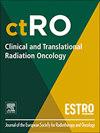补救性立体定向磁共振引导自适应放疗(SMART)再照射治疗局部复发前列腺癌:临床和剂量学结果
IF 2.7
3区 医学
Q3 ONCOLOGY
引用次数: 0
摘要
立体定向消融放疗(SABR)是局部复发性前列腺癌(LRPC)的一种挽救选择;然而,挑战依然存在。立体定向磁共振引导自适应放疗(SMART)允许日常适应、实时跟踪和自动光束门控,在潜在地提高目标覆盖范围的同时允许关键器官保留。2 Gy当量剂量(EQD2)计算允许再辐照中器官危险(OAR)剂量的准确累积。我们报告了每日SMART再照射LRPC的安全性和有效性,以及基于eqd2的OAR耐受计算方法。方法对经组织学证实的非转移性激素敏感性LRPC进行回顾性分析。纳入标准为:放疗后≥18个月,前列腺特异性抗原(PSA)≤30 ng/mL, PSA倍增时间≤6个月,国际前列腺症状评分(IPSS)≤19,前列腺≤80 cc, cT1-T3a /b。再照射方案为30-35 Gy/5次。剂量增强和激素治疗是允许的。建议使用直肠垫片。结果包括毒性、局部控制(LC)、生化无复发生存(bRFS)、无进展生存(PFS)和总生存(OS)。报告了基于eqd2的OAR累积约束估计工作流程。结果2019年至2023年期间,19例患者在首次放疗后中位87个月(范围35-587个月)接受了全腺(n = 12)、半腺(n = 5)或精囊(n = 2)的抢救- smart治疗。所有95个交付的分数都进行了在线适应,满足了所有估计的OAR。经过21个月的随访,急性2级泌尿生殖系统(GU)毒性为21%,未观察到急性≥3级GU或≥2级胃肠道(GI)毒性。3例(15.7%)出现晚期GU 3级毒性。OS为100%;bRFS 73.7%;LC 84.2%;未达到中位pfs。1年和2年PFS分别为94.7%和89.4%。一年期和两年的信用证是100%。在半腺体治疗后观察到2例对侧前列腺内衰竭。结论每日自适应SMART再照射治疗LRPC是可行的、无创的、高LC和低毒性相结合的治疗方法。我们的经验支持将MR指导与个性化的eqd2知情规划相结合。本文章由计算机程序翻译,如有差异,请以英文原文为准。
Salvage stereotactic MR-Guided adaptive radiotherapy (SMART) re-irradiation for locally recurrent prostate Cancer: Clinical and dosimetric outcomes
Introduction
Stereotactic ablative radiotherapy (SABR) is a salvage option for locally recurrent prostate cancer (LRPC); however, challenges remain. Stereotactic MRguided Adaptive Radiotherapy (SMART) permits daily adaptation, real-time tracking and automated beam gating, allowing critical organ sparing while potentially improving target coverage. Equivalent Dose in 2 Gy fraction (EQD2) calculation allows accurate organs-at-risk (OAR) dose accumulation in re-irradiation.
We report safety and efficacy of daily SMART re-irradiation for LRPC, alongside an EQD2-based OAR tolerance calculation method.
Methods
Salvage SMART to histologically proven non-metastatic hormone-sensitive LRPC was retrospectively analysed. Inclusion criteria included: ≥18 months post-RT, prostate-specific antigen (PSA) ≤ 30 ng/mL, PSA doubling-time > 6 months, International Prostate Symptom Score (IPSS) ≤ 19, prostate ≤ 80 cc and cT1–T3a/b.Reirradiation regimens were 30–35 Gy/5 fractions. Dose-boost and hormone therapy were allowed. Rectal spacer was recommended.
Outcomes included toxicity, local control (LC), biochemical relapse-free survival (bRFS), progression free survival (PFS) and overall survival (OS). EQD2-based workflow to estimate OAR cumulative constraints was reported.
Results
Between 2019 and 2023, nineteen patients underwent salvage-SMART to whole-gland (n = 12), hemi-gland (n = 5) or seminal vesicle (n = 2) at a median 87 months (range 35–587) from first radiotherapy. All 95 delivered fractions underwent online adaptation, meeting all estimated OAR.
With 21 months follow-up, acute grade 2 genitourinary (GU) toxicity was 21 % with no acute ≥ grade 3 GU or ≥ grade 2 gastrointestinal (GI) toxicity observed. Late GU grade 3 toxicity occurred in 3 patients (15.7 %).
OS was 100%; bRFS 73.7%; LC 84.2%; and median-PFS was not reached. One and two-year PFS were 94.7% and 89.4%. One and two-year LC was 100%. Two contralateral intraprostatic failures followed hemi-gland treatment were observed.
Conclusion
Daily adaptive SMART re-irradiation is a feasible, non-invasive salvage option for LRPC, combining high LC with low toxicity. Our experience supports integrating MR- guidance with an individualized EQD2-informed planning.
求助全文
通过发布文献求助,成功后即可免费获取论文全文。
去求助
来源期刊

Clinical and Translational Radiation Oncology
Medicine-Radiology, Nuclear Medicine and Imaging
CiteScore
5.30
自引率
3.20%
发文量
114
审稿时长
40 days
 求助内容:
求助内容: 应助结果提醒方式:
应助结果提醒方式:


